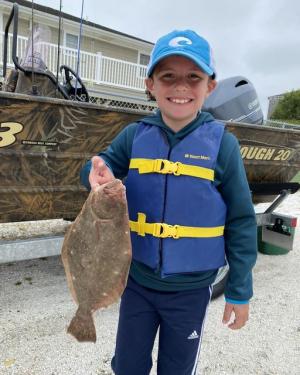The lure of deep-water fishing can be very strong, and I should know, because back in the 1970s and ’80s, I didn’t think I was fishing if we put the lines out inside the 30-Fathom Line.
It all began when my late brother-in-law Paul Coffin bought a 1972 22-Mako with twin 75-horsepower Johnson outboards. That first year we trolled for bluefish at B Buoy, and caught a black drum at the Coral Beds and some trout off Fenwick Island.
But Paul had bigger things in mind. Over the winter, he put a gas tank under the seat forward of the center console, replaced the outrigger bases that had rusted out after one season, added a tackle locker on the raised casting platform and placed a radio locator receiver on top of that. We were ready for the canyons.
Boy, did we have a lot to learn! Our first trip we lucked into a big school of feeding white marlin. We dropped back our rigged ballyhoo that were gobbled up, but when we went to set the hook, nothing came tight.
Later, when talking with a captain at the dock, he asked if we had sharpened the hooks. I said no need to sharpen the hooks; they were brand-new. He took one of the brand-new hooks and showed us just how dull they were. From then on, I set up a sharpening system at my house where I put an edge on every hook before I used it to rig a bait or lure. Today, hooks come sharp as a razor right from the factory.
It took most of the summer, but Paul did catch his white marlin in late August, and I got mine the next week. In those days, a fish didn’t count unless it was brought back to the dock. I had mine stuffed and put over my fireplace until it fell and broke into three pieces.
The next year, we caught the very first white marlin of the season. Lark Benelli was with us on that adventure.
If the offshore bug has bit you, there are things you must be aware of. The first is your boat must be seaworthy. I like a deep-vee hull with plenty of weight. Yes, this type of hull will use more fuel and it will roll in a beam sea, but when things get rough, it will cut through the seas better than any other hull I have ever been aboard, and I have been aboard all sorts of boats.
The next thing you must have is enough fuel to get out there and back, with at least 20% in reserve. If you run from Lewes or Indian River Inlet, it will be 50 or 60 miles to the canyons depending on which one you choose. Figure on how many gallons per hour your boat uses at cruise speed, 25 knots, and then at trolling speed, say six to seven knots. My 24 Albemarle used 12 gallons per hour at my 25-knot cruise speed and two to three gallons per hour at trolling speed. That meant with a two-hour run to the canyon and back, I would use 48 gallons of my 125-gallon tank. That left me plenty of fuel for trolling and I could even change locations if the second place was not too far away.
Today’s electronics are much better than what we had back then. The radio locator beacon was useless. By the time we located the beacon from the Delaware Lightship, we could see it. We used it to listen to Phillies games. GPS is excellent. All we had was a compass.
Please, if you are going offshore, get an EPIRB, aka emergency position indicating radio beacon. They are expensive, but if you are in an emergency situation, they are priceless.
Radar is a very good thing to have if you can afford it. It will not only get you through the fog, but also can be used to spot birds working over fish from quite far away.
There are all sorts of lures out there right now, and most of them work. However, those baits we used back in the ’70s and ’80s still work, and they cost much less.
I would set out a spread with two cedar plugs on the flat lines, two skirted ballyhoo on the outriggers and a Green Machine on the way back. If I was only after white marlin, I would put swimming mullet on the flat lines. There are videos online showing how to rig all sorts of baits.
Finally, go early and come in before the thunderstorms. You won’t miss them all, but once you run through one, you will be reluctant to repeat the experience.

























































